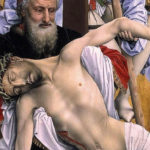February 10, 2019
Year 4, Day 41
For several decades the Sallman painting of Christ was popular with American Christians. It was painted by a Christian of undoubted faith. Who was depicted? Here is a handsome Caucasian man, with a well-manicured beard, and flowing hair, also well combed. There is no jewelry, the robe is dimpled, but plain, clean and appropriate for grooming, and the lighting seems to be from electricity. I enjoyed the rendition in its western handsomeness, but wonder if it is really art at its most realistic to life? Was this a facsimile? Does this characterize Jesus? Was Jesus groomed for the painting? Is the depiction more distant than the ones that offer a darker skin? Was this the matured cherubic baby we see… Read more
January 16, 2019
Year 4, Day 16
Over the decades of my life I have read many writings of scholarly persons, and have been friends of many who enjoy, with me, conversation relating to life on earth in either a humanistic or spiritual orientation. It is interesting to discover that in both orientations there is something of theology. Naturalists sometimes seem to argue theology even when affirming an atheistic context for life. For my purpose on this page I will use the ideas and experiences of Dr. Oliver Sacks, an intrepid neurologist, who at eighty years of age continues his world studies of the functioning of the human mind. The article from an interview by Ron Rosenbaum accents the issues of hallucination. (The SMITHSONIAN, December 2012, Pgs…. Read more
January 13, 2019
Year 4, Day 13
This Page is better understood in readings of Pages for this date in previous volumes that address the knotty problem of biblical meaning and interpretation in the light of human experience. The uniqueness of Scripture from other literature requires adjustment from standard preferences for literature because Scripture is addressing the issues of two very different contexts, one human and one divine. The chasm between the two is so great that Scripture admits to mystery for mankind. If a person is unwilling to exercise faith in God that covers the ultimate mystery that person is limited to humanism. Humanism also has its mystery envelope, but it is assumed that science will attack that mystery to some solutions that will improve the… Read more
November 8, 2018
Year 3, Day 312
After several decades of professional life I discovered from the thrust of Scripture, the clarification of biblical principles, and the discoveries of what worked in the maturing process of my personal life including both natural and spiritual meaning – that God is an affirmative person. He has no negatives. He can use negatives in his communications with mankind because, as many knowledgeable communicator knows, effective communication is in the terms of the persons receiving the communication. In such an understanding Moses set up the extravaganza of Mounts Ebal and Gerizim. The negatives (curses) were shouted from one mountain and were acknowledged from the other with Amen registering that both they and God know the message. The other mount shouted affirmatives… Read more
September 9, 2018
Year 3, Day 252
Both as a visitor and on assignments I have walked or driven along Times Square streets in New York City. The first time was in 1940 and the last time during the late 1990s, more than fifty years after the first event. Since my last visit twenty years have passed to this writing, and I have been reviewing my memory on the emergence of secular and religious culture as represented in this American context that reflect meaningfully the major cultures in the world of influence. New York is for much of the world what Rome was to the Roman Empire, or Athens was to ancient Greece, but not interpreted in militaristic or governmental terms as the Roman and Greek cultures… Read more
August 27, 2018
Year 3, Day 239
For the celebrity, John Kennedy, Jr., his wife, and her sister, the funeral ceremonies in several Catholic Churches were well attended and received world coverage. People lined the streets outside the Churches, and along the curb near the residence of the young Kennedys. Even some reporters (Dan Rather and Barbara Walters were the best known) permitted their own public tears and addressed the dead John Kennedy in heaven – united there with his mother especially). They seemed to believe he could hear what they had to say. Their words were gracious and assuring for the memory of young Kennedy, and for family members preceding him. Those persons were declared to be somewhere on the Elysian Fields. If we were to… Read more
August 18, 2018
Year 3, Day 230
Dreams, fantasies, mythology, and assorted dragons have been important mind furniture since before mankind learned to write, or the various arts created images of other-worldliness. The year of the dragon is meaningful to many Asians. The gods inspired the myths and arts of ancient Greece, and sometimes Rome. Remote tribes possess sometimes exotic myths that have held for millennia. Expressions of this mythology-bent in mankind shows itself in many ways, including astrology, sci-fi creations, and the like. Reviewing the popular series by George R. R. Martin, and especially the fifth book in the series, A Dance With Dragons, Tom Shippey, in his review of the title stated: . . . fantasy is now where the big action is. Millions yearn,… Read more
May 27, 2018
Year 3, Day 147
There is strong belief, in the new millennium beginning the twenty first century, that the peoples of the world, the nations, are more and more turning to secularism. The reasons for the humanistic growth are many, as recited in numerous publications, including S.J.D. Green’s book on: The Passing of Protestant England. Green makes references to the United States and other countries, both in reviewing large negative movements and unexplained exceptions to negative forces impacting the Church. Dallas, Texas is an illustration of offering negative forces, like distracting leisure entertainments (secular/humanistic), but is seen as a force for Christian evangelicalism (spiritual/theistic). The reasons run through a list from boredom with the church, to the victory of the youth culture, to the… Read more
April 26, 2018
Year 3, Day 116
The text here seems unlike any other in the Bible. Like other Psalms from the pen of Asaph, this 82nd Psalm offers a revelation practical to any search for truth about life in the mystery of God. On the surface the few verses teach that there are other gods than God, but that God is the only God. The word gods here is a euphemism. Straightforwardly the writer makes clear that the individuals, commonly identified in the mass as mankind, are gods in the sense of nature gods. Human beings can be gods. (Note the difference here in the lower case ‘g’ in gods – as human, and the singular most high God is identified in capitalization.) It is firmly… Read more
April 18, 2018
Year 3, Day 108
In the context of freedom, the individual is called of God to disciplined life. Freedom means that the individual must self-choose, and maintain control to carry through firmly on constructive resolutions – if that person expects to gain fulfillment so to be unapologetic either to self or God. In this there is a sense of righteousness in the quality of one’s life, not necessarily related to professional and social contexts. It is likely that the pattern will spill over to the social and professional contexts as well, but those entities may be so influenced by forces out of our control that anything we may do, will not assure success, as success is measured in the entity. For example, we may… Read more







